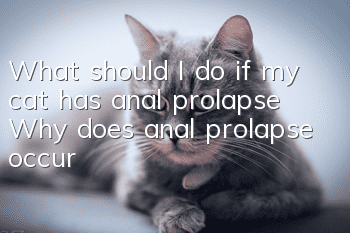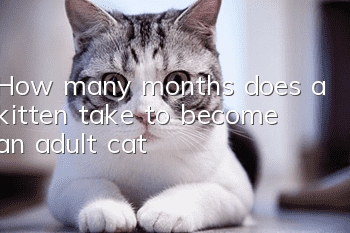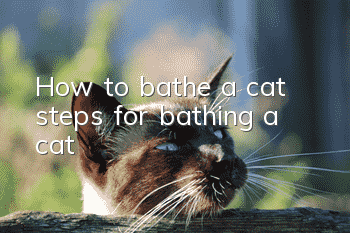What should I do if my cat has anal prolapse? Why does anal prolapse occur?

Nowadays, more and more friends are raising cats. In daily life, due to the influence of various factors such as environment and life, cats are often troubled by diseases. So what should you do if your cat has prolapse? Just follow the editor of Mengpet.com to find out more.
Anal prolapse in cats is also called rectal prolapse, or anal exstrophy. Generally speaking, rectal prolapse in cats is closely related to long-term diarrhea and intussusception. Increased abdominal pressure is the main cause of rectal prolapse. In addition, long-term constipation in cats can also lead to anal prolapse. Severe anal prolapse will cause intestinal decay, but the systemic symptoms are mild, and may include depression, loss of appetite, or incontinence.
1. What is anal prolapse?
A "sausage"-like columnar and drooping swelling can be seen in the cat's anus, which is congested or edematous. The surface is dirty, coated with hair and mud, and the mucous membrane is ulcerated and necrotic. It is often accompanied by elevated body temperature, depression, and decreased appetite. And frequently perform defecation postures.
2. Why does anal prolapse occur?
Long-term severe diarrhea, weakness, constipation, severe exertion during childbirth, or prostatitis. This disease can be caused when cats are malnourished due to severe intestinal parasites, excessive fiber in the feed, and lack of protein and vitamins.
If the cat has rectal prolapse due to long-term diarrhea, a fecal examination must be performed. It is likely to be due to coccidia. Coccidia is more difficult to cure. Generally, doctors will prescribe Happy Brown Sugar and Symbida. Personally, I feel that Happy Brown Sugar is easier to feed.
If the cat prolapses due to excessive force on the anus (such as constipation), the cat may have ingested a foreign object that is difficult to expel, so it cannot pull it out even if it tries hard every day. Once the cat cannot poop out for more than three days, please press its belly with your hands to see if there is any accumulation of feces. If the cat screams when you press it, it may have eaten hard foreign objects such as plastic or needles. Please call as soon as possible. Seek medical treatment and take films. If there is no scream and there is obvious accumulation of feces, then it may have eaten soft foreign objects such as cotton thread. Cotton threads are relatively light, and generally short ones can be discharged, but if they are too long and hang at the base of the tongue, they can only be removed by opening the abdomen. Even if the cotton thread is short, don't be too happy, because even the cotton thread is like a saw in its small intestine. This is like having a hemp rope stuffed in a person's intestines. If you pull it randomly, it can easily scratch the cat's intestinal wall.
3. Diagnosis of anal prolapse
It is easy to make a judgment based on the location, appearance and characteristic clinical manifestations of this disease. However, it is necessary to consider and judge whether there is intussusception in the intestine. If the diagnosis is ignored and only the prolapsed intestine is repaired, it will be very difficult. Will relapse soon. The method of distinguishing between simple rectal prolapse and intussusceptive rectal prolapse is to palpate the early prolapsed intestine. The former is empty and the latter is solid. The second is to repair the prolapsed rectumAfter abdominal palpation, the former's abdominal cavity was soft and there was an overall feeling of emptiness, while the latter's could palpate a section of solid, inelastic sausage-shaped intestine.
4. What should you do if you discover anal prolapse?
After being sent to the hospital, the doctor will recommend flushing with 01% sulfamethoxazole under general anesthesia. Then wrap it with clean gauze and gradually introduce it into the anus. After confirming the reset of the intestine, do the cigarette pack suturing. The treatment and prognosis of the animal depends on the cause of the prolapse, the extent of the prolapse, and whether it is recurrent. For acute rectal prolapse with only minor tissue damage, manual reduction and perianal purse-string suture fixation are recommended. Irreducible prolapse or severely damaged prolapse requires excision. If rectal prolapse recurs after manual reduction or excision, colopexy should be performed.
Colopexy creates a permanent link between the serosal surface of the colon and the abdominal wall to prevent movement of the posterior colon and rectum. Colopexy is frequently used to prevent recurrence of rectal prolapse with good results. Precautions: Do not penetrate the colon and intestines during the operation, which may cause complications.
After the rectum is repositioned, corresponding diarrhea, constipation and other diseases causing anal prolapse will be treated.
- What are the four essential nutrients for cats?
- Are Ragdoll cats big cats?
- How do you think Garfield is pure or not?
- If your cat licks its fur excessively, prepare a WOWO hair removal cream!
- What will happen if a cat licks an externally dewormed cat?
- Kitten snores while sleeping
- Why does a cat lose its teeth?
- Can Ragdoll cats jump very high?
- It is very important to improve the bad habits training of Siamese cats. Siamese cat training methods!
- Can cats spray flower dew?



